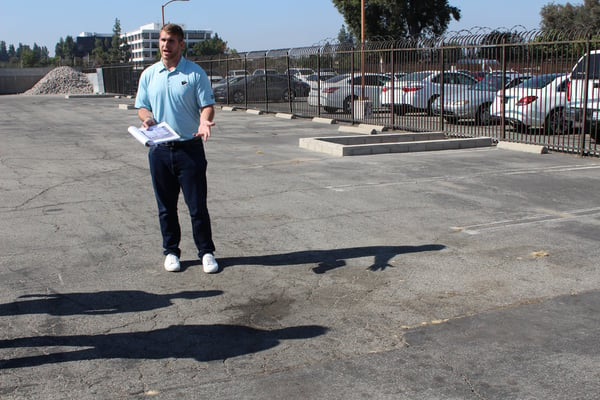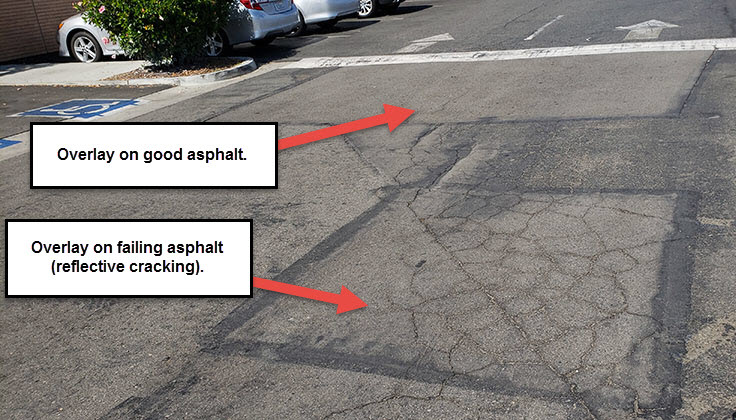An asphalt overlay can be an economical way to repair asphalt that is too far gone for simple patching. But it is not a solution that can be used repeatedly or under all conditions. If you are thinking of starting an asphalt repair project, you'll want to know what your options are. In this post, we'll talk about what an asphalt overlay is, when it is used, and when it cannot be used. Hopefully, this will give you some understanding of which options might be available for your situation.

What Is Asphalt Overlay?
If your asphalt is cracked badly enough that simply sealing the cracks or patching the holes would not result in a satisfactory result, but you do not want to spend money on a full removal and replacement of the existing asphalt, then an asphalt overlay might be a solution for you. Asphalt overlays put a layer of new asphalt over the top of your existing asphalt, giving it a like-new appearance and hiding the cracks.
A binding agent, which acts similar to glue, is placed between the old asphalt and the new asphalt in order to ensure proper adhesion and help further protect the old asphalt from the effects of weathering. Another option is to place petromat between the two layers. A petromat is a special type of fabric that will do an even better job of protecting the old asphalt from causing problems. Most notably, petromat will delay that formation of reflective cracks, which will talk about in a later section
How Is Asphalt Overlay Used?
Because less material is used, and because the old asphalt does not need to be ripped up before installation, asphalt overlays are quite a bit cheaper than a full removal and replacement. This makes them a very attractive middle ground option when patching is not enough and a full replacement is more than you want to take on.
An asphalt overlay will take a cracked asphalt surface and make it attractive again. It will serve to delay the further degradation of the surface, but it is not the same thing as repairing the cracks. Eventually, those cracks will resurface and become a problem again.
What Is Reflective Cracking?
When traffic drives over an area of an asphalt overlay where there are cracks in the underlying layer of asphalt, it creates a pressure point on those cracks. Because of this, cracks will eventually form in the new asphalt layer in nearly the same location that they were in the old asphalt layer. These cracks are called reflective cracks because they are like reflections of cracks in the underlying layers. Reflective cracks are a big part of the reason that asphalt overlays are not a permanent solution to your asphalt repair needs.
As we mentioned earlier, petromat is a nice solution to delay the onset of these reflective cracks. It will also help delay other problems that may be caused by wear, tear, and weather. This is because petromat creates a water barrier between your new surface and your old one. Since it is harder for water to make its way down to that lower surface and expand the existing cracks, the impact of those cracks on the upper layer is minimized.

When Is Asphalt Overlay Not Enough?
Petromat can be a great option for making asphalt overlays viable on surfaces that might otherwise be too damaged for it to be an economical solution. As long as you maintain a regimen of asphalt sealing and crack repair every two years or so depending on traffic, then you can extend the life of your pavement up to 15 years with petromat.
However, petromat is the last line of defense. Eventually, a surface and its underlying layers of asphalt will become so badly damaged that petromat is no longer an option. Eventually, age, wear, and tear, get the best of every asphalt surface. At that point, temporary repairs, even long term solutions such as asphalt overlays, are no longer an option and more permanent solutions must be employed to ensure the safety, functionality, and aesthetic appeal of your surface.
What Happens When Asphalt Overlay Is Not Enough?
Unfortunately, in the life of every asphalt surface, there comes a time when it is just too far gone for any of the temporary repairs to be worthwhile. At this point, the surface has reached the end of its life and must be replaced. In order to replace an existing asphalt surface, the old surface must first be removed. A new layer of asphalt is then applied. Because this new layer is being applied from nothing, it is thicker and costlier than an asphalt overlay is.
Because a complete removal and replacement is the same thing as starting over from scratch, more complex problems can be addressed. Specifically, problems with the underlying soil that might make other forms of repair impractical. Of course, since you will have a brand new asphalt surface on a freshly repaired subgrade, this is the most complete and effective repair that you can undertake.
Conclusion
Because of the cost, most people want to put off a full removal and replacement for as long as possible, opting instead of the most cost-effective option of an asphalt overlay. As we've seen, there are times when an asphalt overlay just isn't the best option anymore. Repairs aren't just about finding the cheapest solution, but finding the most cost-effective.
At Empire Parking Lot Services, we want to provide you with the most cost-effective procedure that we can. Our business depends on customers knowing that we are going to do right by them. If you have an asphalt problem and are not sure whether you need an overlay or a full replacement, please contact us and allow us to take a look at your parking lot. We will provide you with an accurate assessment of the damages and the repairs needed. We'll also explain our reasons to you clearly so that you are not left wondering why we recommend the course of action that we do.




Comments